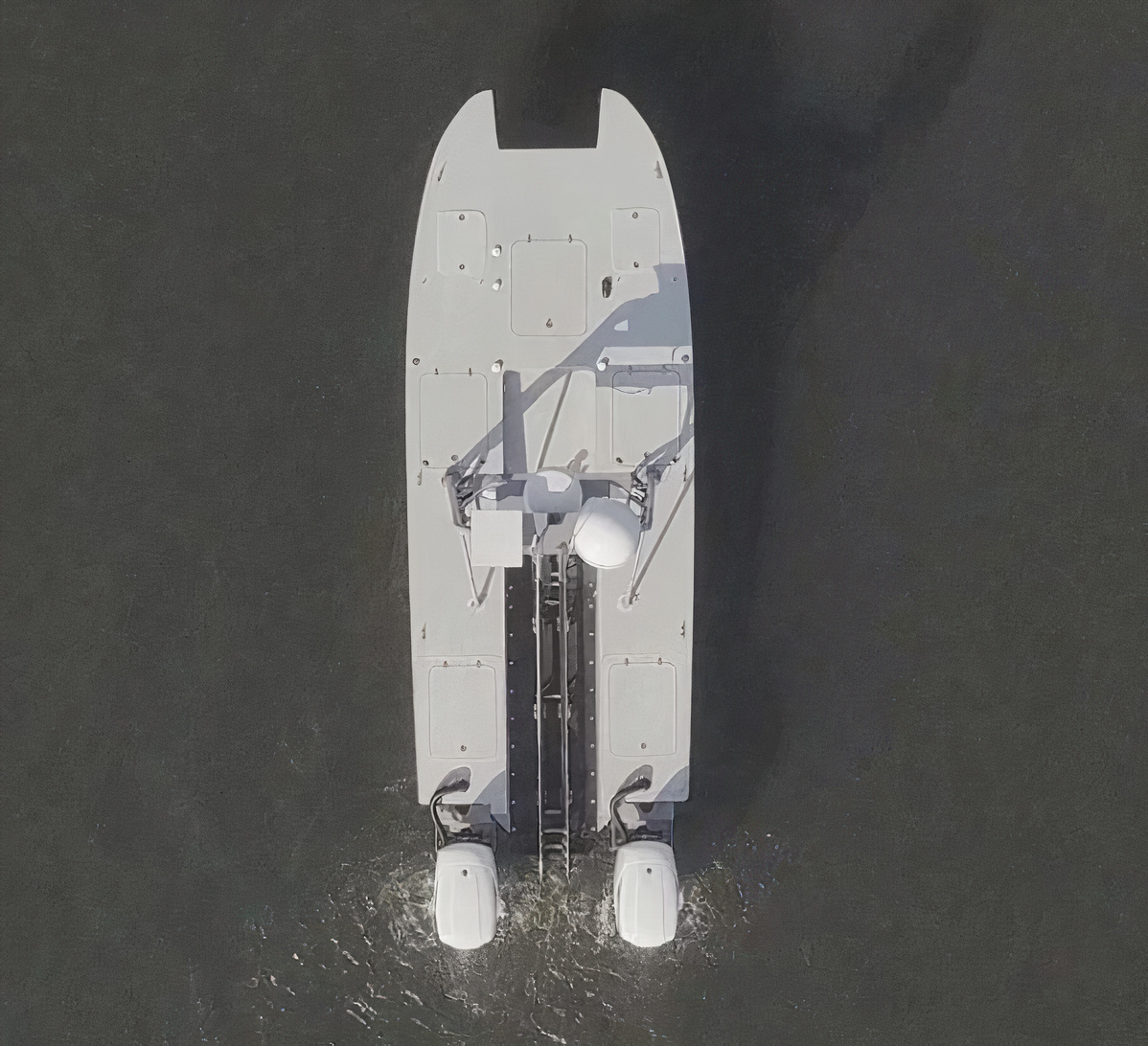The “Productionized” Devil Ray Unmanned Surface Vessel
MARTAC has been working on autonomous maritime systems for more than a decade. They have worked from the beginning on USVs that worked together rather than simply being lone wolf systems; they operate as wolfpacks.
In the past decade, they developed two workhorse USVs and have taken these worldwide to evolve their capabilities and to work with various navies in shaping the payload-platform combinations which these customers desired. The two systems the MANTAS and the DEVIL RAY have provided two different form factors for a USV. The MANTAS being a 12-foot boat and the DEVIL RAY T-38 a 38-foot boat.
These boats are catamarans, not V-shaped hull vessels. Clearly, V-hulls have the advantage of cargo space for there is a top deck and a lower deck which is usually necessary for the personnel that operate them. The small boat catamaran being unmanned clearly does not need a lower deck, so we start with that simple point. The inherent speed advantages of a catamaran hull are clearly obvious as there is no need to support manpower with a lower deck.
And the aerodynamics are different between the two hull forms. As Bruce Hanson, the CEO of MARTAC, argued: “The V-hull operates by splitting through the water; the catamaran by creating an air cushion between the two hulls and the water. This air cushion adds stability to the operation of the boat for this air cushion operates as a shock absorber as well as providing lift. As you increase the speed of the catamaran in operations, the ride gets smoother as well because of the air cushion it creates. In other words, the speed which a smaller catamaran is capable of allows it to operate properly from an aerodynamic design point of view. The more air also provides for less wetted surface and thus less drag.”
He noted that the Austral LCS in comparison does not operate at speeds that take full advantage of the speed and stability attributes of the smaller boat catamaran form. In comparison to the Austral LCS (as cargo and personnel truck), the MARTAC USVs perform like a fighter jet that can operate at higher speeds efficiently,
Hanson then pointed out that the catamaran smaller boat form provides for significant stability as well for the payloads onboard which can include humans if a special operation requires them. “The single point of the V-hull operates like a gymnast on a balance beam. With the catamaran design the gymnast now has two feet on the ground with much greater stability.”
And if you want the USV to go ashore, the catamaran smaller boat form can go directly onto the beach, for example. The catamaran will still stay flat when you’re running onto a shore.
Autonomous USVs are operating in an innovative area when one understands the legacy platform-payload dichotomy. In legacy systems, departments of defense work with contractors to build that platform through a long process of systems engineering and production. And there are paired through the process with core payloads for which the platform was designed to carry.
USVs are entering a new area in which platform and payload become conjoined into a much flexible and rapid upgrade process. They should be understood as platforms which can operate a variety of payloads swapped out rapidly to enable various mission threads for the combat forces.
As Commodore Darron Kavanagh, Director General Warfare Innovation, Royal Australian Navy Headquarters, put it in my recent interview with him in his office in Canberra, Australia: “One of the issues about how we’ve been looking at these systems is that we think in terms of using traditional approaches of capability realization with them. We are not creating a defense capability from scratch. These things exist, already, to a degree out in the commercial world, regardless of what defense does. AI built into robotic and autonomous systems are in the real world regardless of what the defence entities think or do.
“And we have shown through various autonomous warrior exercises, that we can already make important contributions to mission threads which combat commanders need to build out now and even more so going forward.”
And that is really the next point. The use of maritime autonomous systems is driven by evolving concepts of operations and the mission threads within those evolving CONOPS rather than by a platform-centric traditional model of acquisition. CDRE Kavanagh pointed out that traditional acquisition is primarily focused on platform replacement, and has difficulty in supporting evolving concepts of operations.
This is how he put it: “We’re good at replacing platforms. That doesn’t actually require a detailed CONOPS when we are just replacing something. But we now need to examine on a regular basis what other options do we have? How could we do a mission in a different way which would require a different profile completely?”
Enter the Devil Ray T24. This is first fully “productized” MARTAC USV, according to Stephen Ferretti of MARTAC. What this means is that the T24 has been built from the ground up to operate as an autonomous maritime system which can carry a variety of payloads already demonstrated on the MANTAS and the DEVIL RAY. The Devil Ray T24 is built with both size and speed to accommodate new and evolving mission threads.
According to Ferretti: “We have built a system which is agnostic with regard to payload. It is designed from the ground up to swap out payloads as desired by the customer and dependent on their operational needs in the particular situation they are facing.”
Such a capability when combined with other innovative platforms can create true disruptive change.
In short, introducing a productionized T24 can accelerate the kind of change which U.S. and allied force need now, not in some distant future. In fact, one could envisage their role being significant in a sea denial mission in the waters west of Taiwan in enhanced deterrence in the near term.

